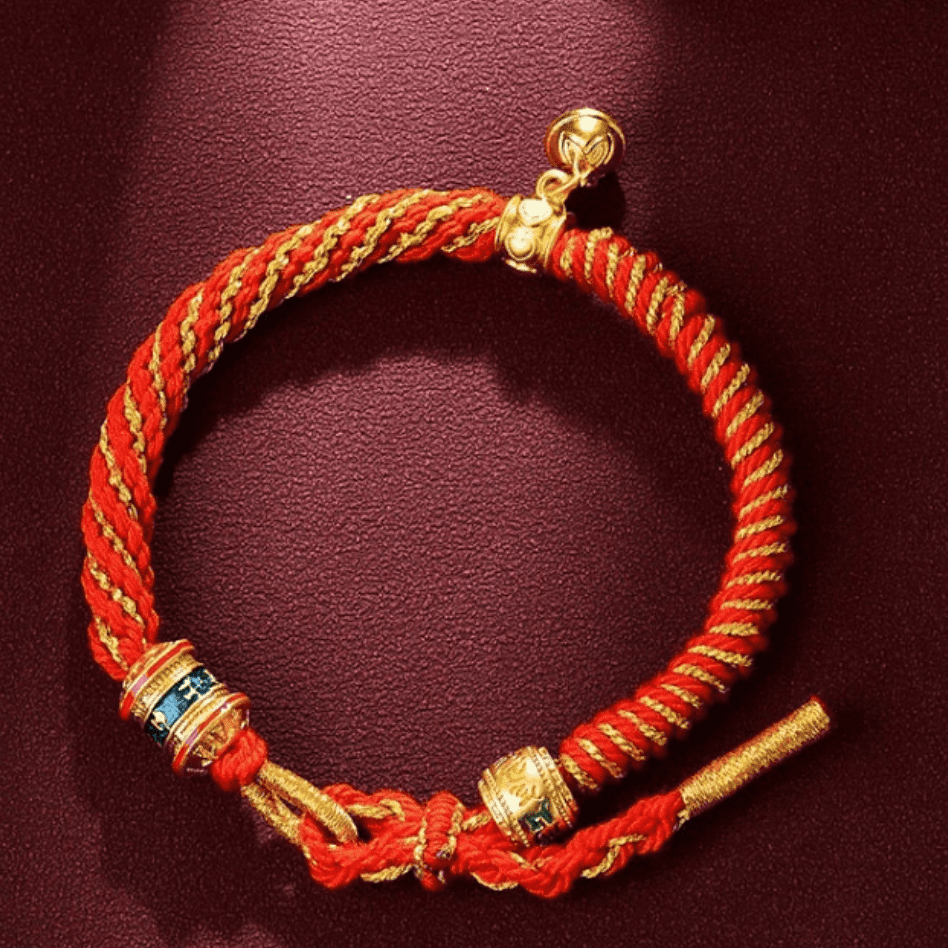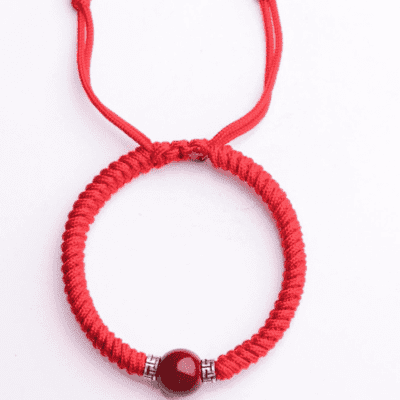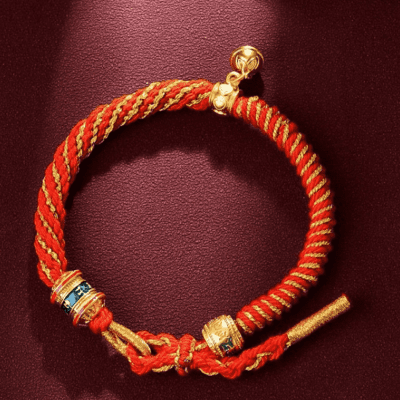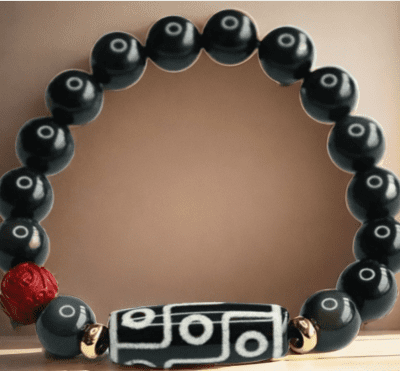Tibetan Prayer Rope Bracelet: A Wristbound Tapestry of Himalayan Mantras, Dharma Protection, and Healing Knots

When the highland wind carries the clang of prayer wheels from Drepung Monastery, and nomads’ hands trace the Om Mani Padme Hum on mani stones, a faint warmth brushes the wrist—this is no ordinary cord. These Tibetan prayer rope bracelets are threads dyed in Lasa’s sunset, twisted with centuries of butter – lamp smoke; fragments of temple – blessed cords, once used by Gelugpa monks to bind demonic obstacles, now polished by time into Zen – like loops; metal amulets inscribed with vajra symbols, accidentally falling into a pilgrim’s pouch and journeying along circumambulation routes to become guardians at the wrist. Every knot carries the dust of Mount Kailash, the resonance of Tengyur chants, and the trembling of the Six – Syllable Mantra, pulsing gently at the wrist as if to whisper the Himalayas’ millennial mysticism to modern souls.

1. Ancient Roots: When Tibetan Spirits Met Knot Magic
Tibetan prayer rope bracelets trace their lineage to the Tubo Dynasty, intertwined with the legend of Guru Rinpoche’s “demonic – binding cords.” In the 8th century, as the master constructed Samye Monastery, demons disrupted the earth’s energy. Guru Rinpoche wove red cords with vajra knots, inscribing mantras on metal beads, and buried them at the monastery’s four corners—these cords, imbued with dharma power, became the prototype of Tibetan prayer ropes. Within every red thread lies the thunder of that demon – subduing act, and every metal bead holds the temple – guarding mantras.
Long before Buddhism, Bon shamans wove “spirit – guiding ropes” from yak hair, using knots to channel mountain spirits. The rough texture of these ropes, catching firelight like caged stars, once witnessed shamans’ trances where they conversed with the spirits of Lake Manasarovar. In Tibetan Buddhism, prayer ropes evolved into “dharma – protecting cords.” A bracelet with mani beads (like the inscribed cylinders in images) symbolizes the Dharma Wheel, its knots embodying the union of wisdom and method—echoing the Lamrim’s teaching that “all practices are but the weaving of intention and action.”
2. Meanings Woven in Knots and Beads
Each bracelet is a tapestry of symbols, stitched with Himalayan wisdom, and often whispered in temple legends:
- Red Rope (Wisdom of Manjushri): Tibetans call red ropes “the threads of Manjushri’s wisdom.” Legend has it that when Manjushri manifested on Mount Wutai, his compassion transformed blood – red karmic obstacles into red threads. Wearing a red – rope bracelet is like wrapping Manjushri’s wisdom around the wrist, cutting through ignorance—much like the sharp edge of a vajra sword, slicing through the darkness of confusion.
- Mantra Beads (Voice of the Buddha): The cylindrical beads inscribed with Om Mani Padme Hum are not mere decorations. In Tashilhunpo Monastery, a lama once saved a drowning child by throwing a mantra – bead bracelet into the river; the child emerged unharmed, wrapped in the bracelet’s light. Since then, mantra beads have been revered as bearers of the Buddha’s voice, dispelling misfortune.
- Vajra – Shaped Clasp (Protection of Padmasambhava): The golden clasp shaped like a vajra echoes Guru Rinpoche’s divine weapon. When the master subdued the demoness of Lake Yamdrok, he forged a vajra clasp to seal her malice—wearing it, one feels the guru’s protection, as if a shield of dharma light surrounds the wrist.
- Auspicious Knot (Cycle of Wholeness): The eight – eyed knot at the end represents the Eightfold Path, its loops embodying the endless flow of samsara and nirvana. In the Nyingma tradition, a high lama once tied an auspicious knot for a dying disciple, saying, “This knot is the Buddha’s embrace of all phenomena.” Wearing it, one hears the whisper of Zen’s “interdependence,” embracing all with equanimity.
3. Why Wear a Tibetan Prayer Rope Bracelet?
Beyond adornment, they are portals to Tibetan mysticism and dharma protection, their power rooted in centuries of spiritual lore:
- Healing Presence: Just as Guru Rinpoche used ropes to balance the elements, red ropes calm the mind (fire element), mantra beads purify karma (water element)—each knot tunes into a different frequency, harmonizing body and spirit as Himalayan lamas do in meditation. A nomad once recounted: “After wearing a red – rope bracelet, my chronic wrist pain miraculously eased.”
- Mystical Connection: Bracelets with vajra clasps (or ancient amulet fragments) link you to dharma guardians. In Ngari, a herder found a vajra – clasped bracelet in a cave; soon after, his family escaped a landslide unharmed. It’s as if carrying a fragment of Guru Rinpoche’s demon – binding cord, whispering secrets of protection.
- Style with Soul: In modern fashion, these bracelets blend Tibetan motifs with minimalist design—red ropes paired with sleek metal clasps (echoing the union of compassion and wisdom), mantra beads with wooden accents (recalling the interdependence of samsara and nirvana). They’re not just accessories but stories on the wrist, like fragments of Terma (hidden teachings) revealed.
4. Choosing Your Tibetan Prayer Rope Bracelet
Let the bracelet choose you, guided by intuition and the whispers of Tibetan legends:
- For Wisdom: Red – rope bracelets with Manjushri – inscribed beads, like the vibrant design, ignite insight—as if holding a thread of Manjushri’s wisdom from Mount Wutai.
- For Protection: Bracelets with vajra clasps, their golden glow shielding you—perfect for facing challenges, like a nomad’s vajra – blessed amulet on a perilous journey.
- For Wholeness: Bracelets with eight – eyed knots, their loops reminding you of life’s cycles—wear them during transitions, as the Karmapa wears knot – tied cords when crossing spiritual thresholds.
- For Mystery: Bracelets with ancient – style metal amulets, their patina igniting curiosity—each symbol a brushstroke of Bon shamanic lore, guarding your path like a mountain spirit’s blessing.
5. The Psychology of Wearing Sacred Adornments
Tibetan prayer rope bracelets work on the mind as much as the spirit, their power amplified by centuries of devotional practice:
- Tactile Grounding: The rough texture of the rope or the cool touch of metal beads anchors you in the present—like spinning a prayer wheel during anxiety, as the Thirteenth Dalai Lama did in times of turmoil.
- Visual Reminder: A glance at the mantra beads or vajra clasp reconnects you to your intention—wisdom, protection, or peace—turning routine into ritual, as monks turn mani stones into mantras.
- Cultural Reverence: Wearing these bracelets honors Tibetan wisdom, fostering a sense of belonging to something timeless—like chanting mantras that transcend eras, as the Ganden Phodrang’s prayers have for 600 years.
6. Tibetan Prayer Rope Bracelets in Modern Fashion: A Bridge of Eras
Today’s designers fuse Tibetan heritage with contemporary elegance, weaving temple legends into every knot:
- Minimalist Zen: Red ropes paired with gold – filled clasps, like the image’s delicate design, blend Tibetan dharma protection with urban chic—perfect for office or meditation, as a modern yogi carries the dharma in style.
- Bohemian Spirit: Multicolored ropes with antique – style metal beads, echoing nomadic jewelry, suit free spirits—each knot a story of the plateau’s winds, as a khampa warrior’s amulet once did.
- Statement Pieces: Bracelets with intricate vajra knots, their bold design making a cultural statement—wear them to honor Tibetan artistry at galas, as a jetsun (noble lady) once adorned herself with knot – tied jewels.
7. Caring for Your Tibetan Prayer Rope Bracelet
Treat them as sacred companions, and they’ll whisper temple secrets for years:
- Energetic Cleansing: Place them under Lasa – time moonlight (full moon preferred) to recharge, as Tibetan temples cleanse relics in the Gesar epic’s celestial light. Smudge with juniper smoke from Tsurphu Monastery for deeper purification.
- Physical Care: Wipe metal beads with a soft cloth to keep their luster; avoid soaking red ropes in water (they absorb Manjushri’s wisdom, and moisture may dull their power). Store in a silk pouch, away from harsh chemicals—like a terma chest hiding sacred texts.
- Restringing with Intention: If knots loosen, restring them mindfully—each knot a prayer, like a monk tying a khata for a long – lost disciple, weaving new intentions into the old dharma.
8. Conclusion: Bracelets as Gateways
Tibetan prayer rope bracelets are more than fashion—they’re living bridges between Himalayan mysticism, dharma protection, and your soul. Whether the red rope ignites wisdom (echoing Manjushri’s compassion), the vajra clasp shields you (as Guru Rinpoche’s magic), or mantra beads purify karma (like the Buddha’s voice), each bracelet carries a fragment of the plateau’s wisdom.
Let them pulse as reminders: in the chaos of modern life, there’s a whisper of Tibetan mountains (where Padmasambhava meditated), a stillness of dharma halls (echoing the Kanjur’s teachings), and a healing pulse of ancient knots (holding Manjushri’s wisdom)—all within reach, at your wrist.
FAQs
Q: Can non – Buddhists wear Tibetan prayer rope bracelets?
A: Absolutely. Their power lies in respect and intention. Wear them as symbols of beauty, protection, or cultural appreciation—just as Tibetans greet all with an open heart, as the Four Immeasurables teach: boundless love, compassion, joy, and equanimity.
A: Absolutely. Their power lies in respect and intention. Wear them as symbols of beauty, protection, or cultural appreciation—just as Tibetans greet all with an open heart, as the Four Immeasurables teach: boundless love, compassion, joy, and equanimity.
Q: How to tell if a Tibetan – style bracelet is authentic?
A: Look for natural wear in knots (like the patina of a pilgrim’s decades – old cord), and check the craftsmanship—authentic pieces have a “handmade energy,” like a nomad’s rope forged under the mountain spirits’ watch.
A: Look for natural wear in knots (like the patina of a pilgrim’s decades – old cord), and check the craftsmanship—authentic pieces have a “handmade energy,” like a nomad’s rope forged under the mountain spirits’ watch.
Q: Do these bracelets have specific spiritual meanings, or can I assign my own?
A: Both. Traditional meanings (Manjushri’s wisdom, Guru Rinpoche’s protection) offer guidance, but your personal intention—wisdom, courage, peace—infuses them with unique power, like a mantra you whisper to the knots, as a tulku (reincarnate lama) infuses amulets with new blessings.
A: Both. Traditional meanings (Manjushri’s wisdom, Guru Rinpoche’s protection) offer guidance, but your personal intention—wisdom, courage, peace—infuses them with unique power, like a mantra you whisper to the knots, as a tulku (reincarnate lama) infuses amulets with new blessings.
Q: What if a bracelet’s knot loosens?
A: Some see it as a release of old karma, as the Bardo teaches; practically, it’s a chance to restring with new intentions—like a phoenix rising from ashes, or a prayer wheel restarting its journey, carrying your renewed vows.
A: Some see it as a release of old karma, as the Bardo teaches; practically, it’s a chance to restring with new intentions—like a phoenix rising from ashes, or a prayer wheel restarting its journey, carrying your renewed vows.

